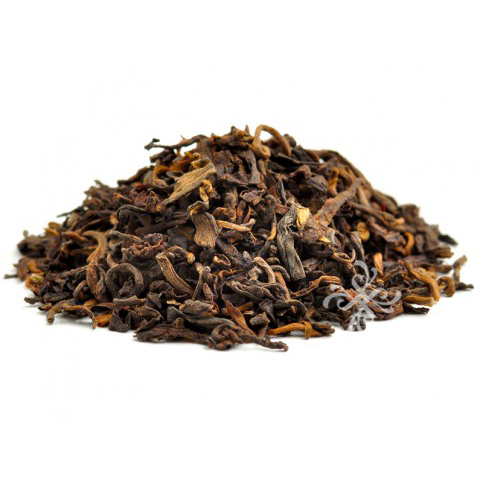Puerh Teas (Hei Cha):
Puerh tea
Puerh is a fermented dark tea. It's the only tea that undergoes true fermentation involving microbes like bacteria and fungi. Other teas that are said to be fermented (blacks and oolongs) are actually just oxidized by enzymes on the leaf surface.
This tea is made by aging for upwards of 3 years in cold, damp caves. Newer methods use environmental controls to speed up the fermentation process to just a few months. The differences in these processing methods are referred to as "raw" (natural), and "cooked" (cultured in a lab to quicken fermentation time).
Generally, the natural method is preferred, though many can't tell the difference. Some evidence suggests that "cooked" puerh contains more medicinal value, however many tea connoisseurs prefer the flavour produced from "raw" forms.
Technically, only tea produced in this way (secondary fermentation), that is made in the Yunnan province can be called Puerh, however teas made using the same methods are produced all over, with the most famous being Xishuangbanna.
The tea starts as a mostly unoxidized green tea, processed from a large leaf variety of Camellia sinensis (C. sinensis var. assamica), or a different large leafed cultivar known as Da Ye or Qimau (suggested to be a new species, Camellia taliensis). These trees grow high up in the mountains of Yunnan province.
In the highest quality puerh teas, the leaves of a very specific set of old trees (100+ years old) in the Yunnan province are used. The tea is then semi sun dried, and pan fried to arrest the enzyme activity and prevent oxidation. Once this is complete, the leaves are rolled, rubbed, and left in the sun to further dry. Then, the tea goes under a secondary oxidation process and fermentation involving various strains microrganisms found naturally on the leaves.
Puerh can be made and fermented as loose leaf tea (quicker) or in cakes (better for long term storage and presentation). Like a fine wine, pressed puerh cakes get better with age. Generally puerh is left to ferment for 10-25 years, while some are suggested to be 50 years old or older and can be worth tens of thousands of dollars.
Colour in puerh teas varies greatly from green (younger teas), to dark brown or red (older teas). The flavour can change a lot as well, becoming smoother, and more earthy in older teas. Puerh also begins to lose its astringent and grassy flavours as it ages.
Brewing Puerh Tea:
Pu-erh is easy to brew because it doesn't tend to become bitter as easily as other teas. A very strong puerh will have a flavour more similar to coffee, and is still enjoyable.
The traditional Chinese way of brewing, however, involves very short brewing times (20-40 seconds). Special Yixing tea pots and tiny cups are used for this process.
The Western method is similar to black tea, using 1-3g of puerh per 250mL, hot water, and steeping time between 2 and 4 minutes depending on how strong you want the tea to taste.
Temperature:
80-100 degrees celsius
Timing:
Anywhere from 20 seconds to 4 minutes.
Types of Puerh Tea
+ Mao Cha
Chinese. Raw, un pressed puerh. Has not been secondarily fermented yet, though can be consumed as is but will not deliver the dark, earthy characteristics of puerh.
+ Sheng Cha
Chinese. This is basically raw, Mao Cha that has been pressed into cakes of various shapes. This has not been through the secondary fermentation yet, and thus is often bought, and stored for decades to be drunk later in life. It can however be drunk as is, but will resemble green tea more than it will the earthy, fermented puerh teas. This is a broad term to refer to all unfermented puerh cakes in pressed form.
+ Shou Cha
Chinese. This is Sheng Cha that has undergone the secondary fermentation process. These categories are a broad term to descripe a variety of puerh types.


